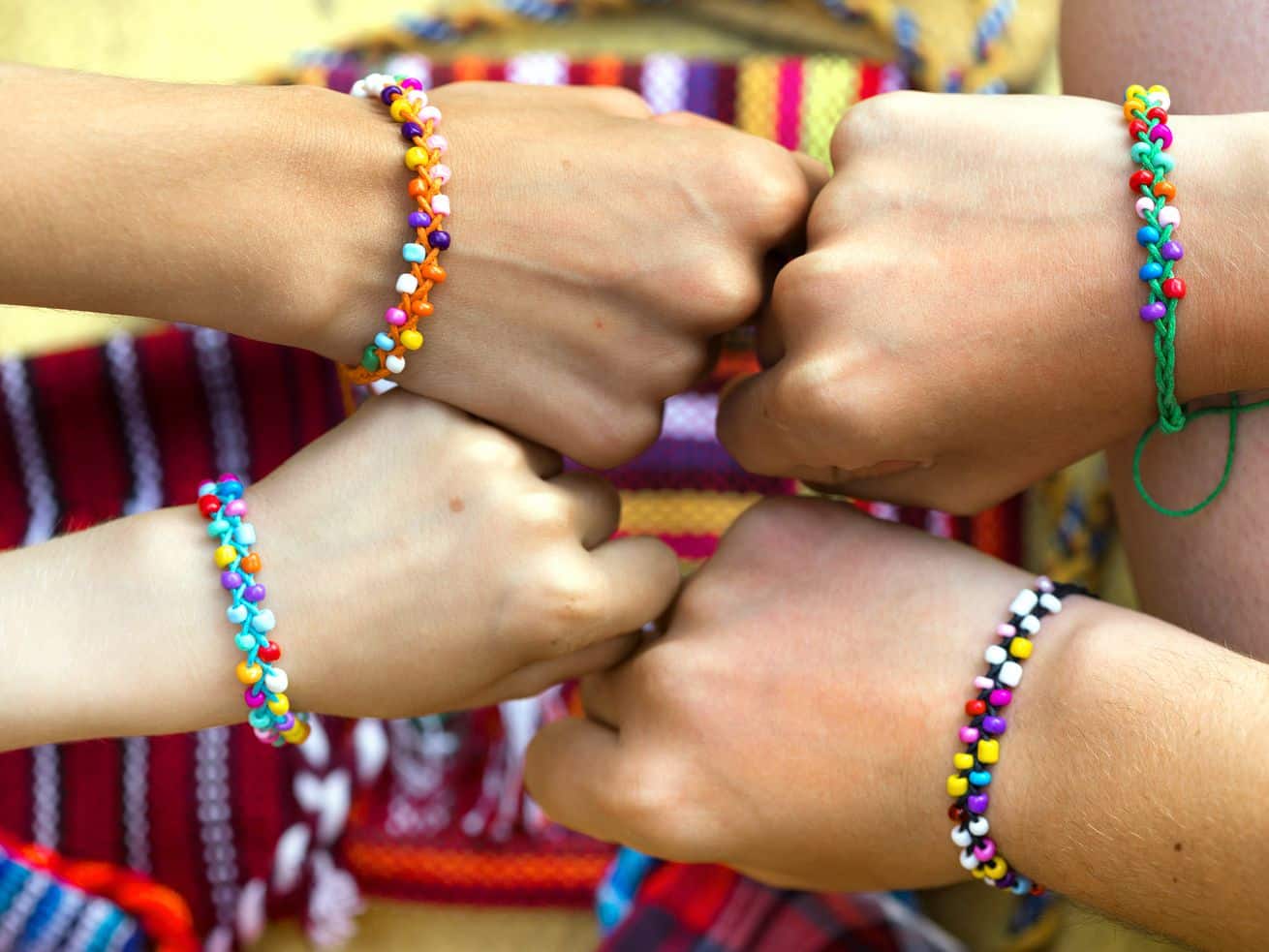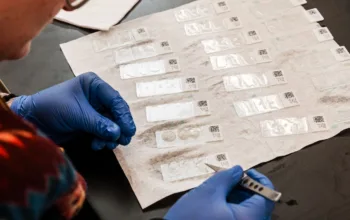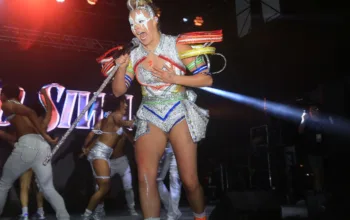Beads are back.
Welcome to Noticed, The Goods’ design trend column. You know that thing you’ve been seeing all over the place? Allow us to explain it.
What is it: Custom bead accessories, the famed relics of summer camp, have been resurrected to remind us that multicolored, far-out necklaces and bracelets can still make us feel cool in a post-pandemic summer. Handmade DIY bead jewelry is back, providing a source of artistic and fashion expression with glossy-coated oblong shapes. While modern pieces are still campy, they have been rebranded as maximalist statements for those looking to accessorize while reminiscing their childhood.
Where is it: The bead jewelry you’ve been seeing on your social media feeds is most likely handmade by an individual artist. Accounts like @beepybella started selling custom handmade jewelry at the start of quarantine, and since have amassed over 38,000 followers. Her beads have been sported by the likes of Bella Hadid, Dua Lipa, and Ella Emhoff. Instagram isn’t the only place bead artists like to sell their jewelry. Etsy, Depop, and other popular DIY sites where jewelry artists can sell directly to their customers are full of beads too.
Why you’re seeing it everywhere: Fashion tends to adhere to the 20-year rule: What is popular now will be popular again in 20 years.
The rise of the DIY subculture in the 1970s paved the way for beaded, woven, collectible jewelry that was a staple in the American summer camp zeitgeist. Tube socks, primary-colored clothing, and friendship bracelets captured the wet, hot American summer aesthetic that made a resurgence in the ’90s. Growing up in the ’90s and early ’00s meant showing off your bead accessories on the first day of school. It was one way of reminiscing on summers past, and capturing the feelings of nostalgia that invaded classroom daydreams. Beads dangled from our necks, wrists, and ankles as constant reminders of fun times with friends. These custom bead accessories have been rebranded as nostalgic statements — a kind of escape from the Covid hellscape — while being a popular way to support small businesses and express gender fluidity.
As we enter a new decade, 20 years ago we were seeing the popular Y2K aesthetic flood pop culture. From escapist music videos to chunky iMacs, we were obsessed with surrealist worlds using what was then new technology.
In the early 2000s, we were on edge. Y2K fears spooked Americans, and we grieved through the 9/11 attacks, only to be faced with war in the Middle East. Similarly in 2020, we faced new challenges — this time, it was a pandemic, another economic recession, and several civil rights movements that sent us looking for a frivolous escape.
Enter beaded necklaces. They’re an accessory that captures ’90s vaporwave and 2000s glam to help us take on the new decade. If you visit Isabella Lalonde’s account @beepybella, you are entering her world of strange shapes, mushrooms, flowers, and mismatched colors. While Lalonde’s aesthetic is personal and done through a lens of fine art, she uses hazy filters, fantasy imagery, and digital art to show off her beaded necklaces to her followers.
“Perhaps, it reminds many of the charming type of imagination they had when they were younger. I know for myself, this sort of fantastical world-building art form has acted as a coping mechanism while I was growing up,” says Lalonde.
If you are a ’90s kid, you probably turned to the internet as a way to escape the realities of growing up. Early internet imagery of late-1990s web design, glitch art, anime, and 3D-rendered objects have a nostalgic, vaporwave feel recalling the innocence of childhood. Remembering the internet’s early days and going to summer camp combines a feeling very similar to the “cottagecore” aesthetic, using “vintage maximalism” imagery rooted in ’90s and 2000s nostalgia. However, cottagecore isn’t just a visual aesthetic. The New York Times describes it as an all-inclusive budding movement. Although complex, the trend seems to be a reaction to increased screen time and criticism of capitalism. The cottagecore universe centers being sustainable, community-driven, and anti-big business.
“Even in our research we find that smaller brands are bringing a lot of newness to the table and they cater to huge markets like millennials and Gen Z,” says Ana Correa, the footwear and accessory editor at WGSN.
Correa says that younger buyers are looking for nostalgic sources of inspiration. Popular hashtags like #vintagefits are dominating Instagram and TikTok as young users share their thrifting hauls from secondhand stores. Gen Z has also been investing in fashion pieces that remain relevant for years, with a large spike in consumers ages 12 to 24 buying more jewelry year over year.
“This major shift drove interest in fashion jewelry with a playful and childlike aesthetic as it mixes high-low materials. Mood-boosting designs have also trended upwards to counterbalance the stress that we experienced globally during the lockdown period. Bright colors and nostalgic motifs have been key to convey this sentiment,” said Correa.
“Slow design” is extremely important to Lalonde. Not only does she find it fundamentally more sustainable, but it is also a beautiful process.
“Buying jewelry from a small brand completely changes your perception of consumerism. It lies in the details,” explains Lalonde. “For example, I spend hours and hours designing the perfect unboxing experience that is not only unique and exciting, but also sustainable in the fact that every material I source is recyclable, compostable, or biodegradable,” she says. “As a designer, one of the most important tasks I place upon myself is to seek objects that are overlooked within our society and make them desirable. That’s pure magic to me.”
Kate Van Petten, a 27-year-old independent musician, knows the importance of supporting small artists, as their livelihood depends on it. Van Petten only buys jewelry from small, sustainable brands in order to aid the next generation of creators and protect our environmental future. “When you shop small brands, you’re voting with your dollar. You’re giving an independent artist the chance to carve a path for their creative future. You’re embedding yourself as a part of their story, and you get to wear that every day,” they said.
Another jewelry designer, Presley Oldham, has also been seeing success in selling his handmade jewelry since the start of the pandemic. A one-man operation, Oldham does his best to make sure all his materials are consciously and locally sourced or upcycled from thrift stores.
Like Lalonde, Oldham also launched his line on Instagram and sells from a small self-titled site. His brand is less cottagecore, but still nostalgic — puka shells and all.
@alicessandraa BEADED CROCS TUTORIAL PART 1 #beadedcrocs #diycrocs #diybeadedcrocs #newtrend #summertrend #diytiktok #crocs #beadedjewelry #beadedcroctutorial
“There is definitely a deep sense of nostalgia pulsing through every piece I make. I’m always inspired by memories and past obsessions I had as a young gay kid growing up in Texas. This last collection was kinda my take on the ’90s Abercrombie black-and-white dreamboat ads, and was definitely influenced by the experience of going in that store as a tween,” he says. “I used to wear weird rocks and leaves tied to strings as necklaces since I was a kid, and was a frequent puka shell and gift shop necklace boy too.”
What stands out most about Oldham’s Instagram posts are his models. A good portion of those sporting his bead necklaces are men. Oldham’s customers are “delightfully diverse,” and his customer base might even skew more male.
Gender fluidity and challenging beauty norms have made their way to mainstream content we consume, from Gen Z-centric shows like Euphoria and the Gossip Girl reboot, to genderless fashion hitting the runway. Genderless fashion interestingly coincides with powerful LGBTQ movements of each generation. The ’60s and ’70s saw the androgynous “space-age sleek” with the Gay Liberation Movement, as womenswear designers like Pierre Cardin moved into men’s fashion. The ’90s saw the androgynous grunge age as the AIDS epidemic swirled through the US, and the early 2000s saw the fight for gay marriage as the “metrosexual male” became a vogue term.
“I personally don’t think about gender when creating a collection,” says Oldham. “My pieces are intended for any person who wants to wear them. If you like it and want to wear it — just wear it. That being said, there are definitely many pearl and bead jewelry trends sweeping through menswear right now. I’d love for it to move past the trend stage and just become something that people just wear and don’t question.”
As for the future of bead necklaces, bigger brands are seeming to catch on, with UK-based Missoma launching their “Summer Dreaming” collection and Forever 21 selling colorful bead necklaces for under $10. While this maximalist-bead-wearing craze is igniting, you have to attribute it to creators like Lalonde and Oldham who are pushing the boundaries of what’s in style.
On Gen Z-dominated TikTok, creators are sharing DIY bead tutorials. “As consumers found themselves with more time and in need of a creative outlet, DIY items and kits gained traction during the Covid-19 lockdowns. Activities such as tie-dye, crochet, and knitting became trendy, especially in the youth market. DIY kits allow the user to create a unique piece and learn a new craft,” says Correa.
“Honestly, I have no clue why this trend became so popular so quickly. It shocked me, for sure. I still remember the first time I placed one of my handmade glass mushroom beads on a necklace. I genuinely thought it would be too radical for some people,” Lalonde said. “I wondered if some of my followers would be repulsed at the idea of wearing a mushroom necklace, which is hilarious, because now that is all I see on my Explore page.”
Author: Jack Riewe
Read More



